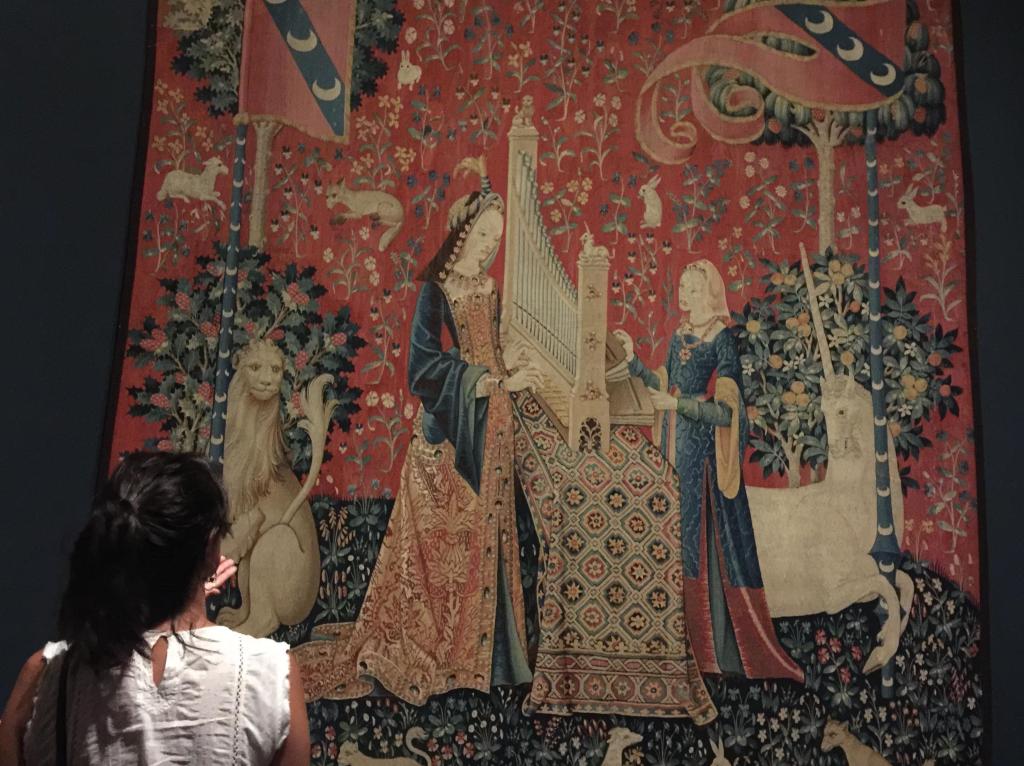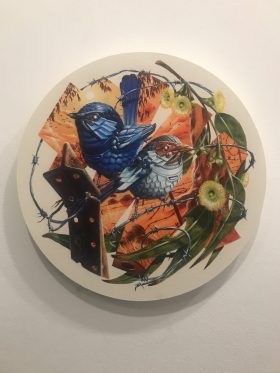Viewing The Lady and the Unicorn tapestries at the Art Gallery of NSW is a pleasure. Photo: Suellen Symons.
Little is known about The Lady and the Unicorn tapestries. They were woven in c.1500, probably in Flanders. In 1841, they were discovered in very poor condition in the Chateau de Broussac. They were purchased and restored in 1882 by the French government for the Musee de Cluny in Paris (now the Musee National du Moyen Age) where they still hang today. This is only the third time The lady and the Unicorn tapestry series has left France in 500 years.
Among other things, the tapestries represent the five senses. Each tapestry is usually referred to by the sense it depicts: Taste, Touch, Smell, Sound and Sight. The sixth, which either introduces or concludes the series, is known as A Mon Seul Desir (To My One Desire), for the words woven into it. It is thought to illustrate that “other sense”, one close to our idea of the soul, mind or heart.
The Musée de Cluny – Musée National du Moyen Âge is a 15th century mansion and an archaeological site built atop the foundations of Roman thermal baths. The museum has housed the six The lady and the unicorn tapestries since the 19th century, overseeing their meticulous restoration in 2012. Today, the tapestries are regarded as ”the Mona Lisa of woven artworks” and one of the greatest surviving artefacts from the Middle Ages.
The general curator of heritage and director of the Musée de Cluny, Elisabeth Taburet-Delahaye has come to the Art Gallery of NSW with the tapestries whilst renovations take place. Discussing the significance of these unique medieval tapestries, their mysterious origins, meanings and their enduring appeal, she gives us, the audience, permission to use our own imaginations to interpret, as we will, the images before us in the tapestries.
They depict a lady flanked by a lion and a unicorn, surrounded by an enchanting world of animals, trees and flowers. One of the most intriguing aspects of these six large-scale artworks is the mystery of their origin and meaning. For whom were they made? What do they symbolise? What stories do they tell?
Unicorns and ladies are surrounded by flowers, a girl feeding a falcon, a lady holding jewels by a small casket, lions with human faces strolling through red gardens, hares looking yonder, dogs lounging, mirrors, reflections, self-reflection, fabric folded, luxuriant – they are meticulously woven.
Detail of The Lady and the Unicorn tapestries, Collection of Musée National du Moyen Âge, Paris
The red backgrounds and the sheer height and size of each tapestry create a mise-en-scene of delight, delight in the garden and all its treasures; delight in the dignity of the ladies and the animals.
The unicorn and the lion are shown bearing the coat of arms of the Le Viste’ family, who commissioned the tapestry suite. The lion, king of the animals, is a symbol of vigilance and loyalty. The unicorn represents purity and chastity, and Christ’s incarnation. The unicorn runs faster than any other animal, so when contemporaries thought of a unicorn they thiought of Viste, which translates as speed.
Anthropomorphism combines with spirituality and sheer scale to address courtly love and carnal knowledge.
First the Lady dons her necklace for the seduction of the unicorn. In the next, she plays the organ to get the unicorn’s attention. Here she is feeding a parakeet and the unicorn has moved closer, though his head is still turned away. He is almost seduced, but needs more temptation.
There are endless stories and curiosities to be found, and it is easy to get lost in then when standing before their beauty. And clearly that feeling is timeless. Three years after the discovery of the tapestries George Sand wrote in her novel Jeanne (1844), ‘These finely worked scenes are masterpieces and if I’m not mistaken, quite a curious page of history’, adding that they were ‘curious’ and ‘enigmatic’ tapestries.
These tapestries continue to be as enigmatic today, and despite our pace and embrace of contemporary life, there is a kind of earthly and magical gateway that they offer which is like an elixir.
Rating: 5 out of 5
The Lady and the Unicorn
Art Gallery of NSW, Sydney
10 February – 24 June 2018






